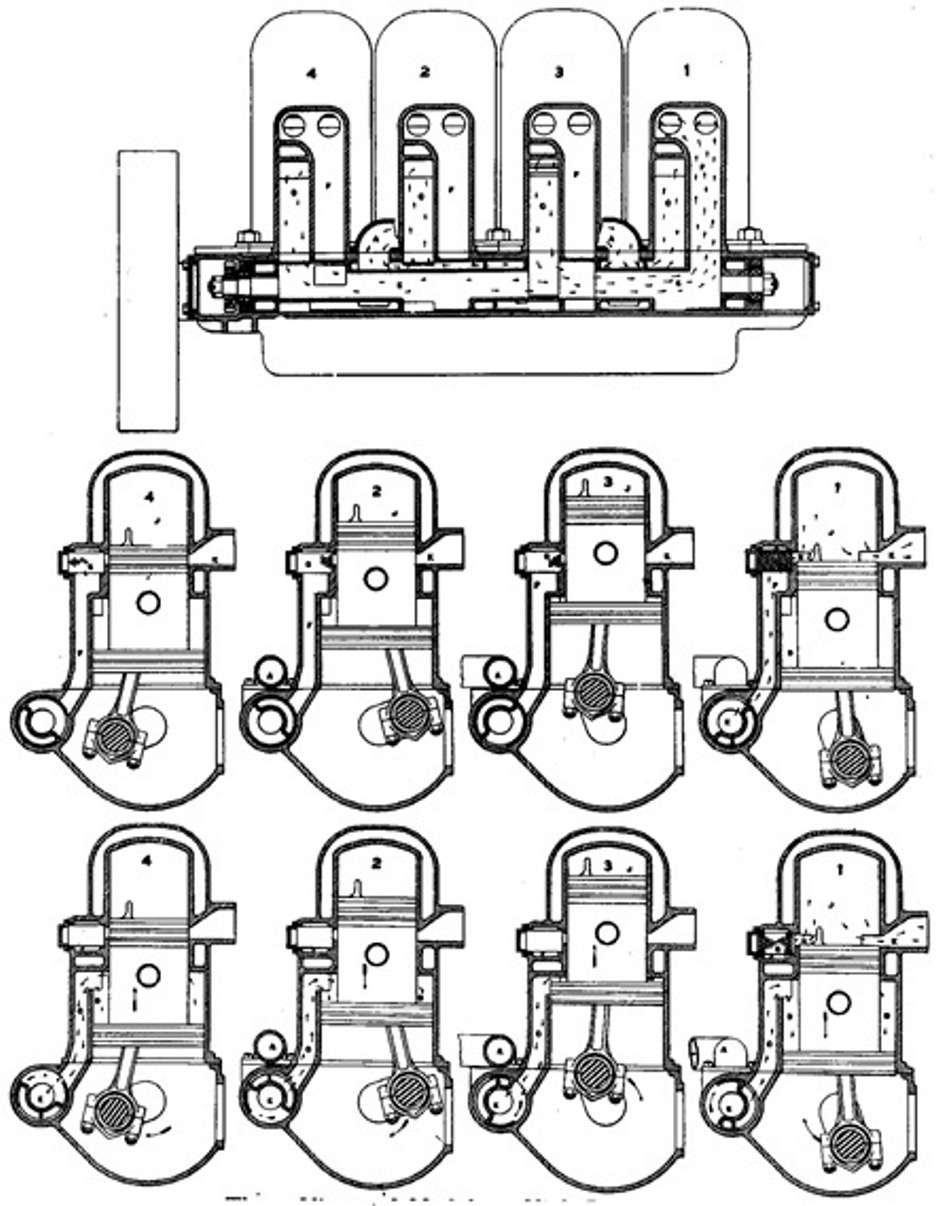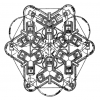
Weird Engines
#1

Posted 14 December 2012 - 15:29
Advertisement
#2

Posted 16 December 2012 - 12:24
#3

Posted 16 December 2012 - 13:55
Nice little story... for a beginner. He needs to hang out here for a while and learn some stuff.
This bloke (and his site) makes everybody look like beginners.
http://www.douglas-s...nusualICeng.htm
#4

Posted 16 December 2012 - 15:16
Blimey! That's going to take some time...
#5

Posted 16 December 2012 - 19:27
Would such a design be able to go more rpms?
#6

Posted 16 December 2012 - 19:28
I really liked the double crank version. Less vibrations right?
Would such a design be able to go more rpms?
I did not notice the archive. I have been looking through it and the core essence is that every single one is more complex than a two stroke or even a four stroke.
Find me a design that is simpler and worked and ill be surpriced.
Edited by MatsNorway, 16 December 2012 - 19:29.
#7

Posted 16 December 2012 - 19:49
http://www.pivotalen....html#animation
http://www.douglas-s.../miscIC.htm#bre go to middle.
Not sure but one benefit is that you can have a narrow "piston" and hence reduce the travel time to and from the ports. If we ignore reliability and efficiency it could make some good power for its cubic size.
Edited by MatsNorway, 16 December 2012 - 19:53.
#8

Posted 17 December 2012 - 02:30
I'd have included Hercules engine- only because it looked so splendid in cutaway (with front like a clockwork)...
#9

Posted 17 December 2012 - 03:23
I really liked the double crank version. Less vibrations right?......Would such a design be able to go more rpms?
Less vibrations? More RPMs? Why do you think so? An I6, V8 or V12 can have excellent balance. As for RPMs, there is no real difference in the crank mechanism's kinematics, so why would it be able to turn higher RPMs?
On the other hand, the dual crank OP engine would be much more costly to manufacture, and would likely have greater friction losses.
Sure, the weird engines shown are interesting. But being different does not mean they are better. The engineers that design automotive engines are not stupid. There's a very good reason all auto engines look the way that they do.
slider
#10

Posted 17 December 2012 - 04:07
Mr Self's really big collection of odd engines is missing three that are still being developed- the Bourke engine, the terminally uninteresting and overhyped Scuderi Engine (fair enough) and the strange yet apparently functional Revetec.
Edited by Greg Locock, 17 December 2012 - 05:29.
#11

Posted 17 December 2012 - 18:39
Less vibrations? More RPMs? Why do you think so?
The rods mass gets "counted out" when its going left right. Dual rods puts less strains on the piston side to side. meaning you can get the piston lighter. having the double rods makes less friction against the sidewalls too.
I quite like the pivotal engine.
Edited by MatsNorway, 17 December 2012 - 18:42.
#12

Posted 18 December 2012 - 02:35
Dr. Paul later used the twin counter-rotating crank architecture at both ends of his ultra high pressure opposed piston diesel engine about 15 years ago.
PJGD
#13

Posted 18 December 2012 - 04:31
Oh you're just trying to score some points with Greg.The engineers that design automotive engines are not stupid.
slider
#14

Posted 18 December 2012 - 04:40
#15

Posted 18 December 2012 - 20:54
#16

Posted 19 December 2012 - 00:37
..........Dr. Paul later used the twin counter-rotating crank architecture at both ends of his ultra high pressure opposed piston diesel engine about 15 years ago...........
PJGD-
Marius Paul's TRC OP recip engine used 4 cranks per cylinder (2 cranks & conrods per piston). While the TRC prototype engine had excellent thermal efficiency, it was due to the extremely high cycle pressures and temperatures and not the cranking mechanism. The friction losses in the dual crank/conrod TRC reciprocator were probably a bit higher than a conventional single crank/conrod arrangement. The TRC engine configuration simply shifts the friction losses that normally occur at the piston skirt to the piston's opposing crankpins, and these forces acting on the crankpins are eventually reconciled at the dual crank phasing gear's mesh point. So in reality, there is no free lunch here.
Having said that, there was actually a very good reason for using the dual conrod/crank configuration on the TRC. The TRC OP engine was designed to operate at peak combustion pressures of 275 bar. It is unlikely that a conventional single conrod/crank mechanism design would have been capable of handling those combustion pressure forces.
Lastly, the dual conrod/crank configuration did have one serious limitation. The wide swing produced by the dual conrods & crank throws limited the practical stroke length, since it created significant interference with the lower end of the cylinder bore.
slider
Edited by bigleagueslider, 19 December 2012 - 01:16.
#17

Posted 19 December 2012 - 01:47
Lastly, the dual conrod/crank configuration did have one serious limitation. The wide swing produced by the dual conrods & crank throws limited the practical stroke length, since it created significant interference with the lower end of the cylinder bore.
slider
Lanchester's flat twin SI engine was mildly under square [Ø5.0" bore x 5.375" stroke]; the UK RAC Horsepower tax which forced highly under square engines came in somewhat later. Dr. Marius Paul's TRC engine, being an OP would have been highly under square too [bore & stroke not immediately to hand]. My guess is that the issue that you have raised was not a big issue for Lanchester, but I can quite see that it would be for the TRC OPE.
PJGD
#18

Posted 19 December 2012 - 06:13
...... Dr. Marius Paul's TRC engine, being an OP would have been highly under square too [bore & stroke not immediately to hand]. My guess is that the issue that you have raised was not a big issue for Lanchester, but I can quite see that it would be for the TRC OPE......
PJGD- The TRC OP engine had the same bore and total stroke as a Detroit Diesel series 92 engine. These dimensions were chosen so that the DDC series 92 could serve as a baseline to judge performance.
#19

Posted 19 December 2012 - 18:21
The TRC engine configuration simply shifts the friction losses that normally occur at the piston skirt to the piston's opposing crankpins,
But crankpins got smooth finish, clearance and a oil film covering them. while the piston is scraping the walls clean with its seals..
So i doubt the no reduction in friction on the piston vs crankpin part.
But did you say that the increased angle on the rods was reducing efficiency? ok.
What about the pivot engine????????
Edited by MatsNorway, 19 December 2012 - 18:23.
Advertisement
#20

Posted 21 December 2012 - 06:56
There is a few that he missed too. The rotary valve section missed the rotary valve head that was fitted to early Holden blocks in the early 60s.. Manufactured here in Adelaide it was never super succesfull but was used in some road cars as well as a few racecars. There is some pics on the Early Holden Racing thread.This bloke (and his site) makes everybody look like beginners.
http://www.douglas-s...nusualICeng.htm
#21

Posted 29 April 2013 - 05:48

#22

Posted 30 April 2013 - 04:23
http://puch250.wordp...twingle-engine/
Some hapless dude reinvented it recently and SouthWest Research are enhancing their income testing and developing it further.
http://www.scuderigr...t-cycle-design/
Basically if you call them piston charged 2 strokes then you can include the fabulous Bourke Engine
http://bourke-engine...eneral_info.htm
...and of course any crankcase compression 2 stroke.
#23

Posted 30 April 2013 - 09:38
Basically if you call them piston charged 2 strokes then you can include the fabulous Bourke Engine
I really enjoyed this story about some old men and their Bourke engine, very entertaining but I have no idea whether it is true or not. And apologies if I've already posted it - I've got a feeling I'm turning into one of those codgers that tell the same story over and over...
#24

Posted 30 April 2013 - 14:20
I really enjoyed this story about some old men and their Bourke engine, very entertaining but I have no idea whether it is true or not. And apologies if I've already posted it - I've got a feeling I'm turning into one of those codgers that tell the same story over and over...
Great stuff!
#25

Posted 30 April 2013 - 14:59
I really enjoyed this story about some old men and their Bourke engine, very entertaining but I have no idea whether it is true or not. And apologies if I've already posted it - I've got a feeling I'm turning into one of those codgers that tell the same story over and over...
I've always enjoyed that story too. In the broadest sense, it's essentially the story of any number of Revolutionary Engines. O true believer.
#26

Posted 30 April 2013 - 21:06
I contacted the author a few years ago and he says it is based on actual events.I've always enjoyed that story too. In the broadest sense, it's essentially the story of any number of Revolutionary Engines. O true believer.
#27

Posted 30 April 2013 - 21:31

#28

Posted 01 May 2013 - 12:29



And not too dissimilar (or wierd) was the Fairchild-Caminez..

#29

Posted 01 May 2013 - 21:35
http://forums.autosp...?showtopic=1782
http://forums.autosp...?showtopic=1793
Alas, almost all the embedded images are loooooong gone
#30

Posted 01 May 2013 - 22:46
Yes indeed, the cam-type engines (both of 'em) were in the second of those links.Nice. I can't recall seeing a cam engine with axially asymmetric lobes before. We did an oddball engines thread (or probably several) yonks ago, they're archived though I suppose so can't be directly commented on. Let's see.
http://forums.autosp...?showtopic=1782
http://forums.autosp...?showtopic=1793
Alas, almost all the embedded images are loooooong gone
I rarely delve into the Tech forum, and in any case I suspect that thread post's from before I even started into the Autosport Bulletin Board so not too guilty re the repetition.
Still, an old codger like myself seems to be needing more and more memory jogging, anyway!
#31

Posted 01 May 2013 - 23:40
EDIT. The maths/geometry involved in making those rockers push and pull the pistons - with asymmetric cam lobes!!! Makes my head hurt.
Edited by gruntguru, 01 May 2013 - 23:51.
#32

Posted 02 May 2013 - 03:46
http://www.revetec.com/
He's trying to get it certified as an aero engine.
#33

Posted 02 May 2013 - 04:37
"The point of maximum mechanical advantage or transfer is around 20-30deg ATDC (when the piston moves approximately 10% of its travel) making the most of the high cylinder pressure. This compares to a conventional engine that reaches maximum mechanical advantage around 60-70deg ATDC. (after the piston has moved through just over 40% of its travel, losing approximately half of the cylinder pressure)."[/font]
OK, so they can produce unconventional piston velocity profiles. This may help with combustion and/or help reduce heat loss to the cylinder but any talk of mechanical advantage is pure uninformed gobbledygook.
#34

Posted 02 May 2013 - 05:13
#35

Posted 02 May 2013 - 05:49
#36

Posted 02 May 2013 - 11:47
#37

Posted 02 May 2013 - 11:58
A nice feature of the aircraft cam engine with 2 lobes is the inbuilt speed reduction - each piston will reciprocate twice while the output shaft rotates only once. Aircraft engines usually need a reduction gearbox to run the prop at an efficient speed.
EDIT. The maths/geometry involved in making those rockers push and pull the pistons - with asymmetric cam lobes!!! Makes my head hurt.
Even a simple SOHC-with-rockers valve gear layout is very clever - the valve lift diagram is perfectly symmetrical but the cam profile is assymetrical to take into account the varying rocker ratio as the cam lobe moves across the surface of the end of the rocker.
The "Dynacam" engine with cylinders and pistons etc. parallel to the axis of the engine's rotation has a similar "half-speed" effect on the output. The promoters of the engine claim the engine has double the torque of a normal engine - another case where torque/power etc. gets a bit confused.
The Dynacam engine has been promoted at regular intervals from the 1940s up to the present day - there is plenty on the internet about it.
Edited by Kelpiecross, 02 May 2013 - 12:10.
#38

Posted 02 May 2013 - 23:12
What makes the aero cam-engine even trickier is its desmodromic - using the same lobe!Even a simple SOHC-with-rockers valve gear layout is very clever - the valve lift diagram is perfectly symmetrical but the cam profile is assymetrical to take into account the varying rocker ratio as the cam lobe moves across the surface of the end of the rocker.




















